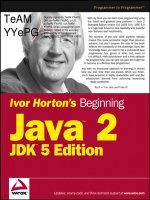OReilly java threads 3rd edition sep 2004 ISBN 0596007825
Bạn đang xem bản rút gọn của tài liệu. Xem và tải ngay bản đầy đủ của tài liệu tại đây (2.46 MB, 776 trang )
•
•
•
•
•
•
TableofContents
Index
Reviews
ReaderReviews
Errata
Academic
JavaThreads,ThirdEdition
ByScottOaks,HenryWong
Publisher :O'Reilly
PubDate :September2004
ISBN :0-596-00782-5
Pages :360
ThreadsareessentialtoJavaprogramming,
butlearningtousethemeffectivelyisa
nontrivialtask.Thisneweditionoftheclassic
JavaThreadsshowsyouhowtotakefull
advantageofJava'sthreadingfacilitiesand
bringsyouup-to-datewiththewatershed
changesinJava2StandardEditionversion
5.0(J2SE5.0).Itprovidesathorough,stepby-stepapproachtothreadsprogramming.
•
•
•
•
•
•
TableofContents
Index
Reviews
ReaderReviews
Errata
Academic
JavaThreads,ThirdEdition
ByScottOaks,HenryWong
Publisher :O'Reilly
PubDate :September2004
ISBN :0-596-00782-5
Pages :360
Copyright
Preface
WhoShouldReadThisBook?
VersionsUsedinThisBook
What'sNewinThisEdition?
ConventionsUsedinThisBook
HowtoContactUs
OrganizationofThisBook
CodeExamples
SafariEnabled
Acknowledgments
Chapter1.IntroductiontoThreads
Section1.1.JavaTerms
Section1.2.AbouttheExamples
Section1.3.WhyThreads?
Section1.4.Summary
Chapter2.ThreadCreationandManagement
Section2.1.WhatIsaThread?
Section2.2.CreatingaThread
Section2.4.TwoApproachestoStoppingaThread
Section2.6.ThreadsandObjects
Section2.3.TheLifecycleofaThread
Section2.5.TheRunnableInterface
Section2.7.Summary
Chapter3.DataSynchronization
Section3.1.TheSynchronizedKeyword
Section3.2.TheVolatileKeyword
Section3.3.MoreonRaceConditions
Section3.5.LockScope
Section3.7.NestedLocks
Section3.9.LockFairness
Section3.4.ExplicitLocking
Section3.6.ChoosingaLockingMechanism
Section3.8.Deadlock
Section3.10.Summary
Chapter4.ThreadNotification
Section4.1.WaitandNotify
Section4.2.ConditionVariables
Section4.3.Summary
Chapter5.MinimalSynchronizationTechniques
Section5.1.CanYouAvoidSynchronization?
Section5.2.AtomicVariables
Section5.3.ThreadLocalVariables
Section5.4.Summary
Chapter6.AdvancedSynchronizationTopics
Section6.1.SynchronizationTerms
Section6.2.SynchronizationClassesAddedinJ2SE5.0
Section6.4.DeadlockDetection
Section6.3.PreventingDeadlock
Section6.5.LockStarvation
Section6.6.Summary
Chapter7.ThreadsandSwing
Section7.1.SwingThreadingRestrictions
Section7.2.ProcessingontheEvent-DispatchingThread
Section7.3.UsinginvokeLater()andinvokeAndWait()
Section7.4.Long-RunningEventCallbacks
Section7.5.Summary
Chapter8.ThreadsandCollectionClasses
Section8.1.OverviewofCollectionClasses
Section8.2.SynchronizationandCollectionClasses
Section8.4.UsingtheCollectionClasses
Section8.3.TheProducer/ConsumerPattern
Section8.5.Summary
Chapter9.ThreadScheduling
Section9.1.AnOverviewofThreadScheduling
Section9.2.SchedulingwithThreadPriorities
Section9.3.PopularThreadingImplementations
Section9.4.Summary
Chapter10.ThreadPools
Section10.1.WhyThreadPools?
Section10.2.Executors
Section10.3.UsingaThreadPool
Section10.5.ThreadCreation
Section10.7.Single-ThreadedAccess
Section10.4.QueuesandSizes
Section10.6.CallableTasksandFutureResults
Section10.8.Summary
Chapter11.TaskScheduling
Section11.1.OverviewofTaskScheduling
Section11.2.Thejava.util.TimerClass
Section11.3.Thejavax.swing.TimerClass
Section11.4.TheScheduledThreadPoolExecutorClass
Section11.5.Summary
Chapter12.ThreadsandI/O
Section12.1.ATraditionalI/OServer
Section12.2.ANewI/OServer
Section12.3.InterruptedI/O
Section12.4.Summary
Chapter13.MiscellaneousThreadTopics
Section13.1.ThreadGroups
Section13.2.ThreadsandJavaSecurity
Section13.4.ThreadsandClassLoading
Section13.3.DaemonThreads
Section13.5.ThreadsandExceptionHandling
Section13.6.Threads,Stacks,andMemoryUsage
Section13.7.Summary
Chapter14.ThreadPerformance
Section14.1.OverviewofPerformance
Section14.2.SynchronizedCollections
Section14.3.AtomicVariablesandContendedSynchronization
Section14.4.ThreadCreationandThreadPools
Section14.5.Summary
Chapter15.ParallelizingLoopsforMultiprocessorMachines
Section15.1.ParallelizingaSingle-ThreadedProgram
Section15.2.MultiprocessorScaling
Section15.3.Summary
AppendixA.SupersededThreadingUtilities
SectionA.1.TheBusyFlagClass
SectionA.2.TheCondVarClass
SectionA.3.TheBarrierClass
SectionA.5.TheThreadPoolClass
SectionA.4.TheRWLockClass
SectionA.6.TheJobSchedulerClass
SectionA.7.Summary
Colophon
Index
Copyright©2004O'ReillyMedia,Inc.Allrightsreserved.
PrintedintheUnitedStatesofAmerica.
PublishedbyO'ReillyMedia,Inc.,1005GravensteinHighway
North,Sebastopol,CA95472.
O'Reillybooksmaybepurchasedforeducational,business,or
salespromotionaluse.Onlineeditionsarealsoavailablefor
mosttitles().Formoreinformation,
contactourcorporate/institutionalsalesdepartment:(800)
998-9938or
NutshellHandbook,theNutshellHandbooklogo,andthe
O'ReillylogoareregisteredtrademarksofO'ReillyMedia,Inc.
JavaThreads,theimageofamarineinvertebrate,andrelated
tradedressaretrademarksofO'ReillyMedia,Inc.
JavaandallJava-basedtrademarksandlogosaretrademarks
orregisteredtrademarksofSunMicrosystems,Inc.,inthe
UnitedStatesandothercountries.O'ReillyMedia,Inc.is
independentofSunMicrosystems,Inc.
Manyofthedesignationsusedbymanufacturersandsellersto
distinguishtheirproductsareclaimedastrademarks.Where
thosedesignationsappearinthisbook,andO'ReillyMedia,Inc.
wasawareofatrademarkclaim,thedesignationshavebeen
printedincapsorinitialcaps.
Whileeveryprecautionhasbeentakeninthepreparationofthis
book,thepublisherandauthorsassumenoresponsibilityfor
errorsoromissions,orfordamagesresultingfromtheuseof
theinformationcontainedherein.
Preface
WhenSunMicrosystemsreleasedthealphaversionofJava©in
thewinterof1995,developersallovertheworldtooknotice.
ThereweremanyfeaturesofJavathatattractedthese
developers,nottheleastofwhichwerethesetofbuzzwords
Sunusedtopromotethelanguage.Javawas,amongother
things,robust,safe,architecture-neutral,portable,objectoriented,simple,andmultithreaded.Formanydevelopers,
theselasttwobuzzwordsseemedcontradictory:howcoulda
languagethatismultithreadedbesimple?
ItturnsoutthatJava'sthreadingsystemissimple,atleast
relativetootherthreadingsystems.Thissimplicitymakes
Java'sthreadingsystemeasytolearnsothatevendevelopers
whoareunfamiliarwiththreadscanpickupthebasicsofthread
programmingwithrelativeease.
InearlyversionsofJava,thissimplicitycamewithtradeoffs;
someoftheadvancedfeaturesthatarefoundinother
threadingsystemswerenotavailableinJava.Java2Standard
EditionVersion5.0(J2SE5.0)changesallofthat;itprovidesa
largenumberofnewthread-relatedclassesthatmakethetask
ofwritingmultithreadedprogramsthatmucheasier.
Still,programmingwiththreadsremainsacomplextask.This
bookshowsyouhowtousethethreadingtoolsinJavato
performthebasictasksofthreadedprogrammingandhowto
extendthemtoperformmoreadvancedtasksformorecomplex
programs.
WhoShouldReadThisBook?
Thisbookisintendedforprogrammersofalllevelswhoneedto
learntousethreadswithinJavaprograms.Thisincludes
developerswhohavepreviouslyusedJavaandwrittenthreaded
programs;J2SE5.0includesawealthofnewthread-related
classesandfeatures.Therefore,evenifyou'vewrittena
threadedprograminJava,thisbookcanhelpyoutoexploitnew
featuresofJavatowriteevenmoreeffectiveprograms.
Thefirstfewchaptersofthebookdealwiththeissuesof
threadedprogramminginJava,startingatabasiclevel;no
assumptionismadethatthedeveloperhashadanyexperience
inthreadedprogramming.Asthechaptersprogress,the
materialbecomesmoreadvanced,intermsofboththe
informationpresentedandtheexperienceofthedeveloperthat
thematerialassumes.Fordeveloperswhoarenewtothreaded
programming,thissequenceshouldprovideanatural
progressionofthetopic.
Thisbookisideallysuitedtodeveloperstargetingthesecond
waveofJavaprogramsmorecomplexprogramsthatfullyexploit
thepowerofJava'sthreadingsystem.Wemaketheassumption
thatreadersofthebookarefamiliarwithJava'ssyntaxand
features.Inafewareas,wepresentcomplexprogramsthat
dependonknowledgeofotherJavafeatures:AWT,Swing,NIO,
andsoon.However,thebasicprincipleswepresentshouldbe
understandablebyanyonewithabasicknowledgeofJava.
We'vefoundthatbooksthatdealwiththeseotherAPIstendto
giveshortshrifttohowmultiplethreadscanfullyutilizethese
featuresofJava(thoughdoubtlessthereverseistrue;wemake
noattempttoexplainnonthread-relatedJavaAPIs).
Thoughthematerialpresentedinthisbookdoesnotassume
anypriorknowledgeofthreads,itdoesassumethatthereader
hasknowledgeofotherareasoftheJavaAPIandcanwrite
simpleJavaprograms.
VersionsUsedinThisBook
WritingabookonJavaintheageofInternettimeishardthe
sandonwhichwe'restandingisconstantlyshifting.Butwe've
drawnalineinthatsand,andthelinewe'vedrawnisatthe
Java2StandardEdition(J2SE)Version5.0fromSun
Microsystems.ThissoftwarewaspreviouslyknownasJ2SE
Version1.5.
It'slikelythatversionsofJavathatpostdatethisversionwill
containsomechangestothethreadingsystemnotdiscussedin
thiseditionofthebook.Wewillalsopointoutthedifferences
betweenJ2SE5.0andpreviousversionsofJavaaswegoso
thatdevelopersusingearlierreleasesofJavawillalsobeableto
usethisbook.
MostofthenewthreadingfeaturesinJ2SE5.0areavailable
(withdifferentAPIs)fromthird-partiesforearlierversionsof
Java(includingclasseswedevelopedinearliereditionsofthis
book).Therefore,evenifyou'renotusingJ2SE5.0,you'llget
fullbenefitfromthetopicscoveredinthisbook.
What'sNewinThisEdition?
ThiseditionincludesinformationaboutJ2SE5.0.Oneofthe
mostsignificantchangesinJ2SE5.0istheinclusionofJava
SpecificationRequest(JSR)166,oftenreferredtoasthe
"concurrencyutilities."JSR-166specifiesanumberofthreadrelatedenhancementstoexistingAPIsaswellasprovidinga
largepackageofnewAPIs.
ThesenewAPIsinclude:
Atomicvariables
Asetofclassesthatprovidethreadsafeoperationswithout
synchronization
Explicitlocks
Synchronizationlocksthatcanbeacquiredandreleased
programmatically
Conditionvariables
Variablesthatcanbethesubjectofatargetednotification
whencertainconditionsexist
Queues
Collectionclassesthatarethread-aware
Synchronizationprimitives
Newclassesthatperformcomplextypesofsynchronization
Threadpools
Classesthatcanmanageapoolofthreadstoruncertain
tasks
Threadschedulers
Classesthatcanexecutetasksataparticularpointintime
We'vefullyintegratedthenewfeaturesofJ2SE5.0throughout
thetextofthisedition.Thenewfeaturescanbesplitintothree
categories:
Newimplementationsofexistingfeatures
TheJavalanguagehasalwayshadthecapabilitytoperform
datasynchronizationandthreadnotification.However,
implementationofthesefeatureswassomewhatlimited;
youcould,forexample,synchronizeblocksofcodeorentire
methodsbutsynchronizingacrossmethodsandclasses
requiredextraprogramming.InJ2SE5.0,explicitlocksand
conditionvariablesallowyoumoreflexibilitywhenusing
thesefeatures.
Thesenewimplementationsdonotintroducenewconcepts
foradeveloper.Adeveloperwhowantstowritea
threadsafeprogrammustensurethatherdataiscorrectly
synchronized,whethersheusesJ2SE5.0'sexplicitlocksor
themorebasicsynchronizedkeyword.Therefore,bothare
presentedtogetherwhenwetalkaboutdata
synchronization.Thesameistrueofconditionvariables,
whichprovidethreadnotificationandarediscussed
alongsideJava'swait()andnotify()methods,andof
queues,whicharediscussedalongwithJava'sother
collectionclasses.
Importantthreadutilities
Atsomepointintime,virtuallyalldeveloperswhowrite
threadedprogramswillneedtousebasicthreadutilities
suchasapoolorascheduler;manyofthemwillalsoneed
touseadvancedsynchronizationprimitives.Arecognitionof
thisfactisonethingthatdroveJSR-166itwascertainly
possibleinpreviousversionsofJavatodevelopyourown
threadpoolsandschedulers.Butgiventheimportanceof
threadingintheJavaplatform,addingthesebasicutilities
greatlyincreasesprogrammerproductivity.
Minimalsynchronizationutilities
Java'snewatomicclassesprovideameansbywhich
developerscan,whennecessary,writeapplicationsthat
avoidsynchronization.Thiscanleadtoprogramsthatare
highlyconcurrent.
Ifyou'vereadpreviouseditionsofthisbook,theconcepts
presentedinthefirsttwocategorieswillbefamiliar.Inprevious
editions,wedevelopedourowndatasynchronizationclasses,
threadpools,andsoon.Inthoseeditions,weexplainedin
detailhowourimplementationsworkedandthenusedthemin
severalexamples.Inthisedition,wefocussolelyonhowtouse
theseclasseseffectively.
Theinformationthatfallsintothethirdcategoryiscompletely
newtothisedition.Theclassesthatperformminimal
synchronizationrequirenewsupportfromthevirtualmachine
itselfandcouldnotbedevelopedindependentofthosechanges.
OrganizationofThisBook
Here'sanoutlineofthebook,whichincludes15chaptersand1
appendix:
Chapter1
Thischapterformsabasicintroductiontothetopicof
threads:whytheyareusefulandourapproachto
discussingthem.
Chapter2
Thischaptershowsyouhowtocreatethreadsandrunnable
objectswhileexplainingthebasicprinciplesofhowthreads
work.
Chapter3
Thischapterdiscussesthebasiclevelatwhichthreads
sharedatasafelycoordinatingwhichthreadisallowedto
accessdataatanytime.Sharingdatabetweenthreadsis
theunderlyingtopicofournextfourchapters.
Chapter4
Thischapterdiscussesthebasictechniquethreadsuseto
communicatewitheachotherwhentheyhavechanged
data.Thisallowsthreadstorespondtodatachanges
insteadofpollingforsuchchanges.
Chapter5
Thischapterdiscussesclassesandprogrammingmethods
thatachievedatasafetywhileusingaminimalamountof
synchronization.
Chapter6
Inthischapter,wecompleteourexaminationofdata
sharingandsynchronizationwithanexaminationof
deadlock,starvation,andmiscellaneouslockingclasses.
Chapter7
Swingclassesarenotthreadsafe.Thischapterdiscusses
howmultithreadedprogramscantakefulladvantageof
Swing.
Chapter8
Javacollectionclassesarewrittenforavarietyof
circumstances.Somearethreadsafeandsomearenot,and
J2SE5.0introducesnewcollectionclassesforuse
specificallywiththreadutilities.Wesortallthatoutinthis
chapter.
Chapter9
SchedulingistheprocesswherebyasingleCPUselectsa
threadtorun.Threadschedulingismoreapropertyofan
operatingsystem(OS)thanaJavaprogram,andthis
chapterdiscussestherelationshipbetweenthevirtual
machineandtheOSinthisarea.
Chapter10
Thischapterdiscussesthreadpoolsacollectionofthreads
thatcanbeusedtorunarbitrarytasks.Weusethethread
poolimplementationofJ2SE5.0fordiscussionofthe
generalprinciplesofusingthreadpools.
Chapter11
Taskschedulersexecuteataskoneormoretimesatsome
pointinthefuture.Thissetofclassesincludestimers(Java
hashadtimerclassessinceJDK1.3)andageneraltask
scheduleravailableinJ2SE5.0.
Chapter12
DealingwithI/Oisoneoftheprimaryreasonswhy
developersusethreadsinJava.Inthischapter,weuseallof
Java'sthreadingfeaturestoshowyouhowtohandleI/O
effectivelyinmultithreadedprograms.
Chapter13
Inthischapter,wecompleteourexaminationofthreadrelatedfeaturesofJavabyexaminingthreadsecurity,
threadgroups,threadstacks,andothertopics.
Chapter14
Performanceofthread-relatedfeaturesandparticularly
synchronizationconstructsiskeytowritingmultithreaded
programs.Inthischapter,wetestvariouslow-level
programmingfeaturesandexploresometruthsandmyths
aboutthreadperformance.
Chapter15
Inthischapter,weshowaprocessforexploitingthepower
ofmultiprocessormachinestocalculateCPU-intensiveloops
inparallel.
AppendixA
J2SE5.0introducesanumberofthread-relatedclasses.
Manyoftheseclassesaresimilartoclassesdevelopedin
previouseditionsofthisbook;welistthoseclassesinthis
appendixasanaidtodeveloperswhocannotyetupgradeto
J2SE5.0.
ConventionsUsedinThisBook
Thefollowingtypographicalconventionsareusedinthisbook:
Italic
IndicatesURLsandfilenames,andisusedtointroducenew
terms.Sometimesweexplainthreadfeaturesusinga
question-and-answerformat.Questionsposedbythereader
arerenderedinitalic.
Constantwidth
Indicatescodeexamples,methods,variables,parameters,
andkeywordswithinthetext.
Constantwidthbold
Indicatesuserinput,suchascommandsthatyoutypeon
thecommandline.
CodeExamples
Allexamplespresentedinthebookarecomplete,running
applications.However,manyoftheprogramlistingsare
shortenedbecauseofspaceandreadabilityconsiderations.The
fullexamplesmayberetrievedonlinefrom
/>Thisbookisheretohelpyougetyourjobdone.Ingeneral,you
mayusethecodeinthisbookinyourprogramsand
documentation.Youdonotneedtocontactusforpermission
unlessyou'rereproducingasignificantportionofthecode.For
example,writingaprogramthatusesseveralchunksofcode
fromthisbookdoesnotrequirepermission.Sellingor
distributingaCD-ROMofexamplesfromO'Reillybooksdoes
requirepermission.Answeringaquestionbycitingthisbook
andquotingexamplecodedoesnotrequirepermission.
Incorporatingasignificantamountofexamplecodefromthis
bookintoyourproduct'sdocumentationdoesrequire
permission.
Weappreciate,butdonotrequire,attribution.Anattribution
usuallyincludesthetitle,author,publisher,andISBN.For
example:"JavaThreads,ThirdEdition,byScottOaksandHenry
Wong.Copyright2004O'ReillyMedia,0-596-00782-5."
Ifyoufeelyouruseofcodeexamplesfallsoutsidefairuseor
thepermissiongivenabove,feelfreetocontactusat
HowtoContactUs
Pleaseaddresscommentsandquestionsconcerningthisbookto
thepublisher:
O'ReillyMedia,Inc.
1005GravensteinHighwayNorth
Sebastopol,CA95472
(800)998-9938(intheUnitedStatesorCanada)
(707)829-0515(internationalorlocal)
(707)829-0104(fax)
O'Reillymaintainsawebpageforthisbook,wherewelist
errata,examples,andanyadditionalinformation.Youcan
accessthispageat:
/>Tocommentorasktechnicalquestionsaboutthisbook,send
emailto:
FormoreinformationaboutO'Reillybooks,conferences,
ResourceCenters,andtheO'ReillyNetwork,seeourwebsite
at:
SafariEnabled
WhenyouseetheSafari®Enabledicononthebackcoverof
yourfavoritetechnologybook,thatmeansthebookisavailable
onlinethroughtheO'ReillyNetworkSafariBookshelf.
Safarioffersasolutionthat'sbetterthane-books.It'savirtual
librarythatletsyoueasilysearchthousandsoftoptechnology
books,cutandpastecodesamples,downloadchapters,and
findquickanswerswhenyouneedthemostaccurate,current
information.
Tryitforfreeat.
Acknowledgments
Asreadersofprefacesarewellaware,writingabookisnever
aneffortundertakensolelybytheauthorswhogetallthecredit
onthecover.Wearedeeplyindebtedtothefollowingpeoplefor
theirhelpandencouragement:MichaelLoukides,whobelieved
uswhenwesaidthatthiswasanimportanttopicandwho
shepherdedusthroughthecreativeprocess;DavidFlanagan,
forvaluablefeedbackonthedrafts;DebCameron,forediting
sometimesramblingtextintocoherency;HongZhang,for
helpinguswithWindowsthreadingissues;andReynold
Jabbour,WendyTalmont,SteveWilson,andTimCramerfor
supportingusinourworkoverthepastsixyears.
Mostly,wemustthankourrespectivefamilies.ToJames,who
gaveScottthesupportandencouragementnecessarytosee
thisbookthrough(andtocopewithhiscontinualstateof
distraction),andtoNini,whoknewtoleaveHenryaloneforthe
tenpercentofthetimewhenhewascreative,andencouraged
himtherestofthetimethankyouforeverything!
Finally,wemustthankthemanyreadersoftheearliereditions
ofthisbookwhosentusinvaluablefeedback.Wehavetriedour
besttoanswereveryconcernthattheyhaveraised.Keepthose
cardsandletterscoming!
Chapter1.IntroductiontoThreads
ThisisabookaboutusingthreadsintheJavaprogramming
languageandtheJavavirtualmachine.Thetopicofthreadsis
veryimportantinJavasoimportantthatmanyfeaturesofthe
threadingsystemarebuiltintotheJavalanguageitselfwhile
otherfeaturesofthethreadingsystemarerequiredbytheJava
virtualmachine.ThreadingisanintegralpartofusingJava.
Theconceptofthreadsisnotanewone:forsometime,many
operatingsystemshavehadlibrariesthatprovidetheC
programmeramechanismtocreatethreads.Otherlanguages,
suchasAda,havesupportforthreadsembeddedintothe
language,muchassupportforthreadsisbuiltintotheJava
language.Nonetheless,untilJavacamealong,thetopicof
threadswasusuallyconsideredaperipheralprogrammingtopic,
onethatwasonlyneededinspecialprogrammingcases.
WithJava,thingsaredifferent:itisimpossibletowriteanybut
thesimplestJavaprogramwithoutintroducingthetopicof
threads.AndthepopularityofJavaensuresthatmany
developers,whomightneverhaveconsideredlearningabout
threadingpossibilitiesinalanguagesuchasCorC++,needto
becomefluentinthreadedprogramming.
Futhermore,theJavaplatformhasmaturedthroughoutthe
years.InJava2StandardEditionVersion5.0(J2SE5.0),the
classesavailableforthread-relatedprogrammingrivalmany
professionalthreadingpackages,mitigatingtheneedtouseany
commerciallibrary(aswassomewhatcommoninprevious
releasesofJava).SoJavadevelopersnotonlyneedtobecome
knowledgeableinthreadedprogrammingtowritebasic
applicationsbutwillwanttolearnthecomplete,richsetof
classesavailableforwritingcomplex,commercial-grade
applications.
1.1JavaTerms
Let'sstartbydefiningsometermsusedthroughoutthisbook.
ManyJava-relatedtermsareusedinconsistentlyinvarious
sources;weendeavortobeconsistentinourusageofthese
termsthroughoutthebook.
Java
First,isthetermJavaitself.Asyouknow,Javastartedout
asaprogramminglanguage,andmanypeopletodaystill
thinkofJavaasbeingsimplyaprogramminglanguage.But
Javaismuchmorethanjustaprogramminglanguage:it's
alsoanAPIspecificationandavirtualmachinespecification.
SowhenwesayJava,wemeantheentireJavaplatform:
theprogramminglanguage,itsAPIs,andavirtualmachine
specificationthat,takentogether,defineanentire
programmingandruntimeenvironment.Oftenwhenwesay
Java,it'sclearfromthecontextthatwe'retalking
specificallyabouttheprogramminglanguage,orpartsof
theJavaAPI,orthevirtualmachine.Thepointtoremember
isthatthethreadingfeatureswediscussinthisbookderive
theirpropertiesfromallthecomponentsoftheJava
platformtakenasawhole.Whileit'spossibletotakethe
Javaprogramminglanguage,directlycompileitinto
assemblycode,andrunitoutsideofthevirtualmachine,
suchanexecutablemaynotnecessarilybehavethesame
astheprogramswedescribeinthisbook.
Virtualmachine,interpreters,andbrowsers
TheJavavirtualmachineisthecodethatactuallyrunsa









